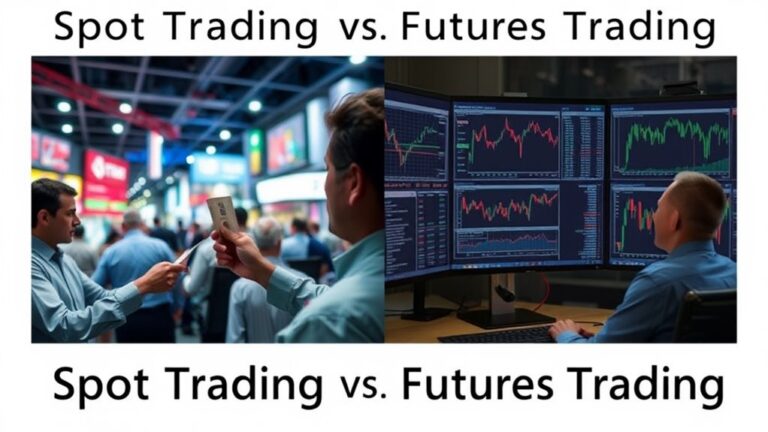
Liquidity and Order Book Depth Explained: What Traders Need to Know
Market liquidity refers to how easily assets can be bought or sold without affecting price. Order book depth shows the volume of buy/sell orders at different price levels. Deep order books absorb large trades with minimal price impact, creating stability and narrow spreads. Shallow books lead to volatility and slippage. Traders analyze depth to identify support/resistance levels and market sentiment. Understanding these concepts helps optimize trade timing, size, and execution strategy. The following sections explore practical applications for different market conditions.
Key Takeaways
- Market liquidity refers to the ease of trading assets at stable prices, characterized by many participants, high volume, and narrow bid-ask spreads.
- Order book depth shows the volume of buy/sell orders at different price levels, with deeper books providing more price stability and lower slippage risk.
- Slippage increases with order size, but can be mitigated through limit orders, order splitting, and timing trades during high-liquidity periods.
- Deep order books reveal reliable support and resistance levels through concentrated order clusters, aiding precise stop-loss placement.
- CEXs typically offer superior liquidity with deeper order books than DEXs, enabling large trades with minimal price impact and faster execution.
What Is Market Liquidity and Why Does It Matter?

The foundation of efficient financial markets rests upon market liquidity, which refers to the ease and speed at which an asset can be bought or sold at a stable price without causing significant market disruption.
Market liquidity directly impacts trading risk by ensuring that positions can be entered or exited without substantially affecting prices.
Liquidity serves as a protective buffer, allowing traders to manage positions without triggering adverse price movements.
Liquidity differs from solvency in that it focuses on short-term market functionality rather than long-term financial stability.
A highly liquid market typically features numerous participants, substantial trading volume, and narrow bid-ask spreads.
These characteristics create an environment where traders can execute transactions efficiently and at predictable prices.
For traders, liquidity serves as an essential risk management tool by reducing price volatility during position changes and minimizing trading costs through tighter spreads. Additionally, understanding limit and market orders is crucial for effectively navigating liquidity in the cryptocurrency market.
Order Book Depth: The Foundation of Market Stability

While market liquidity provides the overall trading environment, understanding order book depth reveals the structural foundation beneath market stability. Order book depth reflects the volume of buy and sell orders at various price levels, directly impacting how prices respond to trading activity.
| Characteristic | Deep Order Book | Shallow Order Book |
|---|---|---|
| Price Stability | High – absorbs large trades | Low – prone to volatility |
| Slippage | Minimal | Significant |
| Manipulation Risk | Lower | Higher |
| Bid-Ask Spread | Narrow | Wide |
| Trading Strategy | More predictable execution | Requires caution |
Markets with deep order books allow substantial trades without significant price movements, reducing slippage and creating a more stable trading environment. Traders analyze order book depth to identify support and resistance levels while gauging market sentiment through the balance of buy and sell orders. Additionally, a user-friendly interface can enhance the trading experience by enabling traders to make informed decisions based on real-time data.
How to Measure and Interpret Order Book Depth

Measuring order book depth effectively requires traders to understand several interconnected metrics that collectively reveal market liquidity conditions.
Volume indicators show how actively a market is trading, while bid-ask spreads provide insight into immediate liquidity costs. Narrower spreads typically indicate higher liquidity.
Higher trading volume and tighter spreads typically signal improved market liquidity conditions worth monitoring.
Market depth charts visually represent the distribution of buy and sell orders at different price levels, helping traders identify potential support and resistance zones.
When analyzing order books, traders should look for imbalances between buy and sell sides, as these often signal potential price movements.
The impact of slippage—how much price moves when executing larger orders—serves as a practical measure of true market depth.
Traders can use platforms like MT4, MT5, and cTrader to access these depth analytics for making informed trading decisions.
The Relationship Between Liquidity and Trading Costs

The relationship between liquidity and trading costs manifests primarily through slippage, spreads, and market timing considerations.
Slippage occurs when larger orders consume multiple price levels in the order book, resulting in execution at progressively worse prices as order size increases.
Traders can minimize costs by analyzing spread fluctuations throughout trading sessions and identifying high-liquidity windows when deeper order books facilitate more efficient trade execution with minimal price impact. Understanding slippage in crypto trading is essential for traders to navigate market volatility and enhance their profitability.
Slippage and Order Size
Every trader inevitably encounters slippage when executing transactions in financial markets, particularly when dealing with larger order sizes.
Slippage represents the difference between expected and actual execution prices, manifesting as either positive (favorable) or negative (unfavorable).
Order size greatly influences slippage occurrence. Larger orders typically consume multiple price levels in the order book, resulting in greater price deviation from expectations. This happens because limited liquidity at any single price point cannot accommodate substantial orders without price impact.
During volatile market conditions, even smaller orders may experience considerable slippage due to rapid price fluctuations.
Traders can mitigate slippage by implementing strategic approaches: using limit orders instead of market orders, breaking larger orders into smaller portions, and timing transactions during periods of higher market liquidity. Additionally, understanding trading pairs is crucial for determining the most favorable market conditions to execute trades effectively.
Spread Impact Analysis
Financial market participants face numerous costs when executing trades, with the bid-ask spread representing one of the most significant and unavoidable trading expenses. This spread directly impacts trading profitability by increasing the cost of entering and exiting positions, especially in less liquid markets.
| Market Condition | Spread Characteristics | Trading Implication |
|---|---|---|
| High Liquidity | Narrow spreads | Lower trading costs |
| Low Liquidity | Wide spreads | Higher trading costs |
| Volatile Markets | Expanding spreads | Increased risk |
Order book depth and spread width are inversely related, with deeper markets typically displaying tighter spreads. Traders analyze spreads across different exchanges and assets to identify ideal trading environments, as tight spreads often indicate efficient markets where prices closely reflect true asset value. This analysis forms an essential component of risk management and trading strategy development. Additionally, the centralized exchanges provide higher liquidity, which can lead to tighter spreads compared to decentralized platforms.
Timing Entry Points
When should traders enter markets to maximize their profits and minimize costs?
The answer lies in understanding liquidity patterns and order book depth.
Traders who monitor market conditions can identify periods of high liquidity, which typically feature narrower spreads and reduced slippage, creating ideal entry opportunities. Additionally, staying informed about regulatory clarity can help traders better anticipate market movements influenced by new laws.
Identifying Support and Resistance Levels Through Order Books

Trading platforms that display order books offer traders a powerful window into market dynamics, revealing where support and resistance levels naturally form. By analyzing order book depth, traders can identify high liquidity areas that often function as market barriers where prices may stall or reverse.
Support levels manifest where buyer interest concentrates, creating price floors where declines typically halt. Conversely, resistance levels appear where seller dominance prevails, often capping upward movements.
The visualization of these order concentrations through heatmaps and order flow analytics helps traders spot potential reversals before they occur. Volume confirmation strengthens these identified levels—increased buying volume near support or selling volume near resistance validates their significance.
Order book heatmaps reveal market sentiments in real-time, exposing reversal points before price action confirms them.
This data-driven approach to identifying critical price levels leads to more precise stop-loss placement and improved trade timing.
Trading Strategies That Leverage Market Depth Data

Market depth data enables traders to implement effective strategies like scalping, which capitalizes on short-term liquidity imbalances between buy and sell orders.
Support and resistance levels become more reliable when confirmed by concentrated order clusters in the order book, providing traders with strategic entry and exit points.
Analysis of market depth also reveals valuable sentiment information, as the distribution and size of pending orders often indicate whether market participants are mainly bullish or bearish at specific price levels.
Scalping Using Liquidity Imbalances
Three critical factors drive successful scalping strategies based on liquidity imbalances in today’s fast-paced financial markets.
First, traders must quickly identify mismatches between buy and sell orders that create temporary price inefficiencies. These imbalances often appear in order book data, revealing opportunities for rapid, small-profit trades.
Second, execution speed becomes paramount when exploiting these imbalances. Traders utilize specialized platforms like MT4 and MT5 that offer the rapid trade placement needed for effective scalping.
Finally, risk management techniques must be tailored to liquidity conditions. Setting appropriate stop-loss levels based on order book depth protects against sudden price movements while maintaining profit potential.
During news events, scalpers can strategically position themselves to benefit from the increased volatility and stop hunts that often follow significant announcements. Additionally, understanding trading strategies is essential for maximizing the effectiveness of scalping in varying market conditions.
Support-Resistance Level Detection
Support and resistance levels provide the foundation for many successful trading decisions, especially when enhanced with market depth data. Traders can more accurately identify these levels by analyzing order book information, which reveals liquidity clusters and supply-demand imbalances.
Historical price action combined with market depth shows where significant buying or selling pressure exists. Areas with high concentrations of limit orders often indicate potential support or resistance zones. When these align with technical indicators like moving averages or Fibonacci retracements, the signal strength increases substantially.
Order book depth helps traders confirm the robustness of these levels by revealing the volume of orders at specific prices. This insight enables more precise stop-loss placement and take-profit targets, reducing risk and improving trade execution timing, particularly during breakouts or trend reversals.
Market Sentiment Analysis
Trading professionals increasingly leverage market sentiment analysis to gain competitive advantages when interpreting order book data. By correlating sentiment indicators with liquidity metrics, traders can identify potential trading opportunities and anticipate market shifts. This combination provides a thorough view of market conditions, enhancing decision-making accuracy.
Sentiment analysis techniques, including news monitoring and social media tracking, integrate effectively with order book depth data to assess market mood. This integration helps traders identify support and resistance levels where sentiment and liquidity align.
Strategic applications include contrarian approaches that capitalize on sentiment extremes, momentum strategies that follow established trends, and event-driven tactics that exploit short-term market responses. Additionally, this combined analysis strengthens risk management by enabling traders to position themselves ahead of potential volatility and adjust their exposure accordingly.
Centralized vs. Decentralized Exchange Liquidity Profiles

Liquidity forms the backbone of any cryptocurrency trading platform, greatly influencing user experience and trade execution. When comparing centralized exchanges (CEXs) and decentralized exchanges (DEXs), significant liquidity differences emerge that traders should consider.
CEXs typically maintain higher liquidity levels with deeper order books, enabling large trades with minimal price impact. Their centralized structure facilitates faster execution speeds and supports greater trading volumes. This robust liquidity environment allows for more predictable trading outcomes.
Robust CEX liquidity provides stability for large traders seeking minimal price impact and predictable execution.
In contrast, DEXs rely on liquidity pools rather than traditional order books. While this innovative approach aligns with blockchain principles, it often results in lower liquidity, potentially causing higher slippage for substantial trades.
DEX transactions also face slower execution times due to blockchain confirmation requirements, affecting time-sensitive trading strategies.
Practical Tips for Trading in Variable Liquidity Conditions

When maneuvering cryptocurrency markets, successful traders must adapt their strategies to accommodate fluctuating liquidity conditions. Timing trades to avoid low liquidity periods helps reduce exposure to excessive price swings and wider spreads.
Selecting assets with adequate liquidity minimizes slippage and guarantees smooth execution.
For strategy selection, traders should consider breakout approaches during increasing volatility, while mean reversion tactics work better in low volatility phases. Range-bound strategies often perform well when prices oscillate within defined ranges during low liquidity periods.
Technical indicators like Bollinger Bands can help identify mean reversion opportunities, while market depth charts provide visual representations of order distribution.
Trading on higher timeframes can mitigate the impact of spreads when liquidity is low, and diversification across multiple strategies helps reduce overall risk exposure. Moreover, choosing a crypto exchange with strong security features can enhance the safety of your trading activities.
Frequently Asked Questions
How Does Order Book Depth Differ Across Various Market Sessions?
Order book depth varies across market sessions due to regional trading activity. It peaks during overlaps like European-US sessions, and fluctuates based on time zones, institutional participation, and regional economic events affecting trader engagement.
Can Market Makers Manipulate Order Book Depth Data?
While legitimate market making exists, market makers can indeed manipulate order book depth through spoofing, layering, and phantom orders—creating illusory liquidity that misleads traders about true market conditions and potential price movements.
What Technology Tools Best Visualize Real-Time Order Book Changes?
The most effective tools for visualizing real-time order book changes include Bookmap with its heat maps, TradingLite’s customizable feeds, FXSSI’s order book snapshots, and various cryptocurrency platforms offering depth charts and volume visualization.
How Do Corporate Actions Impact Order Book Depth Patterns?
Corporate actions dramatically transform order book landscapes. Stock splits generally deepen liquidity by increasing accessibility, while buybacks create buy-side imbalances. Mergers temporarily thin depth amid uncertainty, and dividend announcements shift order flow patterns as investors reposition their holdings.
Does Order Book Depth Analysis Work for Cryptocurrency Futures Markets?
Order book depth analysis is effective for cryptocurrency futures markets. It reveals liquidity patterns, market sentiment, and potential price movements, though traders should note that futures order books often show greater variability than spot markets.
Conclusion
As markets shift between calm waters and turbulent storms, liquidity and order book depth remain the compass and anchor for informed traders. Understanding these fundamentals transforms overwhelming market data into strategic advantages. While newcomers chase fleeting price movements, seasoned traders observe the underlying order flow architecture. Mastering this knowledge doesn’t just improve execution—it fundamentally changes how traders navigate the complex financial landscape.












